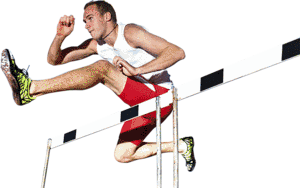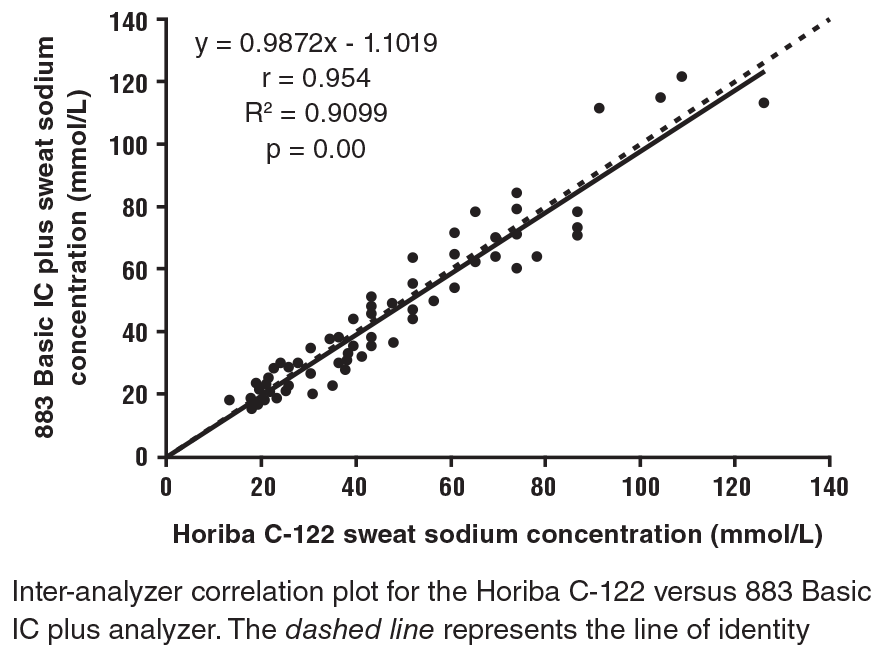

Determining the sodium concentration in sweat and replacing that with proper electrolyte intake prevent fluid and electrolyte imbalances. Sweat can be easily extracted from sterile patches applied on skin and tested with LAQUAtwin sodium ion meter. According to Gatorade Sports Science Institute, the sodium results obtained with HORIBA falls within 15.4 mEq/L 95% of the time.


It is useful to determine the amount of sodium present in sweat as replacing sodium (Na+) lost from sweating plays an important role in preventing fluid and electrolyte imbalances. By finding the amount of sodium lost, one may estimate the amount of electrolyte that should be replaced.
Sweat can usually be tested for sodium content by an ion chromatography techniques in analytical laboratories. But most athletes do not have ready access to such facilities. The Horiba ion tester can be used instead of the traditional ion chromatography in order to determine the amount of sodium in sweat.
The LAQUAtwin Na-11 sodium ion meter is used as simple test to determine the sodium ion content of sweat in order to replace the electrolytes after intense activity. This is an easy, quick method used to check the amount of sodium present in sweat.
When the subject has begun to sweat, the target sites must be cleaned with deionized water and dried. Then, sterile patches can be applied directly onto the right anterior mid-thigh, right posterior mid forearm, left posterior mid forearm, upper chest, right scapula, left scapula, and forehead. The subjects should then continue with their strenuous activity and the patches removed just before they are saturated with sweat.
Sweat is then extracted from the patches. A small sample of the sweat solution extracted is placed on the sensor of the LAQUAtwin Na-11 sodium ion meter and measured. To repeat sampling, wash the sensor with tap water and pat dry with a paper tissue.
By using accurate sodium ion tester for sweat in athletes, we can determine the electrolyte imbalance and thus athletes can better address this by optimising their electrolyte intake during activity.
Though ion chromatography is the gold laboratory standard, the results derived by Horiba’s ion analysis alternate method are not only simpler to acquire, but also accurate.
According to a study by Gatorade Sports Science Institute, ‘On the basis of typical error of the measurement results, sweat [Na+] and [K+] obtained with HORIBA falls within `15.4 mEq/L and `0.68 mEq/L, respectively 95% of the time’.
The LAQUAtwin Na-11 sodium ion pocket meter is small and compact; convenient to carry around the marketplace for easy on-site testing. Its easy-to-use interface is simple for anyone to use.

Lindsay B. Baker, Corey T. Ungaro, Kelly A. Barnes, Ryan P. Nuccio, Adam J. Reimel, and John R. Stofan “Validity and reliability of a field technique for sweat Na+ and K+ analysis during exercise in a hot-humid environment” Physiological Reports Vol. 2 Issue 5 (2014)
Eric D. B. Goulet, Tommy Dion, and Étienne Myette-Côté “Validity and reliability of the Horiba C-1 compact sodium analyzer in sweat sample of athletes” European Journal of Applied Physiology (2012)
У вас есть вопросы или пожелания? Используйте эту форму, чтобы связаться с нашими специалистами.
Pocket Water Quality Meters